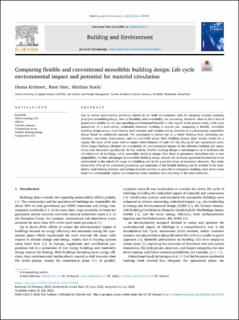Please use this identifier to cite or link to this item:
https://doi.org/10.21256/zhaw-25430| Publication type: | Article in scientific journal |
| Type of review: | Peer review (publication) |
| Title: | Comparing flexible and conventional monolithic building design : life cycle environmental impact and potential for material circulation |
| Authors: | Kröhnert, Hanna Itten, René Stucki, Matthias |
| et. al: | No |
| DOI: | 10.1016/j.buildenv.2022.109409 10.21256/zhaw-25430 |
| Published in: | Building and Environment |
| Volume(Issue): | 2022 |
| Issue: | 222 |
| Page(s): | 109409 |
| Issue Date: | 2022 |
| Publisher / Ed. Institution: | Elsevier |
| ISSN: | 0360-1323 1873-684X |
| Language: | English |
| Subjects: | LCA; Circular economy; Sustainability; Construction; Building; Environment |
| Subject (DDC): | 690: Building and construction |
| Abstract: | Due to severe sustainability problems caused by the built environment, calls for adopting circular economy principles in building design, such as flexibility and reversibility, are increasing. However, there is still a lack of quantitative studies on the corresponding environmental benefits in this regard. In the present study, a life cycle assessment of a multi-storey residential reference building is carried out, comparing a flexible, reversible building design using a load-bearing steel structure and wooden ceiling elements to a conventional, monolithic design based on reinforced concrete. The assessment is carried out on a whole building level, including construction, operation, maintenance, and the end-of-life phase. Both building designs show similar results for a regular life cycle of 60 years without major refurbishment (13 and 14.5 kg CO2-eq/m2 per operational year). When longer building lifetimes are considered, the environmental impact of the reference building per operational year decreases significantly. In this context, flexible building design is advantageous as it facilitates the refurbishment of buildings, while monolithic building design often leads to premature demolition due to low adaptability. Further advantages of reversible building design include the increased potential of materials to be recirculated at the end-of-life stage of a building and in the potential reuse of structural elements. This study shows that 14% of the embodied greenhouse gas emissions of the flexible building can be avoided if the foundation, load-bearing structure and ceiling elements are kept in place for a subsequent building. Such direct reuse leads to a substantially higher environmental value retention than recycling of the same materials. |
| URI: | https://digitalcollection.zhaw.ch/handle/11475/25430 |
| Fulltext version: | Published version |
| License (according to publishing contract): | CC BY 4.0: Attribution 4.0 International |
| Departement: | Life Sciences and Facility Management |
| Organisational Unit: | Institute of Natural Resource Sciences (IUNR) |
| Appears in collections: | Publikationen Life Sciences und Facility Management |
Files in This Item:
| File | Description | Size | Format | |
|---|---|---|---|---|
| 2022_Kroehnert-Itten-Stucki_Comparing-building-design.pdf | 4.45 MB | Adobe PDF |  View/Open |
Show full item record
Kröhnert, H., Itten, R., & Stucki, M. (2022). Comparing flexible and conventional monolithic building design : life cycle environmental impact and potential for material circulation. Building and Environment, 2022(222), 109409. https://doi.org/10.1016/j.buildenv.2022.109409
Kröhnert, H., Itten, R. and Stucki, M. (2022) ‘Comparing flexible and conventional monolithic building design : life cycle environmental impact and potential for material circulation’, Building and Environment, 2022(222), p. 109409. Available at: https://doi.org/10.1016/j.buildenv.2022.109409.
H. Kröhnert, R. Itten, and M. Stucki, “Comparing flexible and conventional monolithic building design : life cycle environmental impact and potential for material circulation,” Building and Environment, vol. 2022, no. 222, p. 109409, 2022, doi: 10.1016/j.buildenv.2022.109409.
KRÖHNERT, Hanna, René ITTEN und Matthias STUCKI, 2022. Comparing flexible and conventional monolithic building design : life cycle environmental impact and potential for material circulation. Building and Environment. 2022. Bd. 2022, Nr. 222, S. 109409. DOI 10.1016/j.buildenv.2022.109409
Kröhnert, Hanna, René Itten, and Matthias Stucki. 2022. “Comparing Flexible and Conventional Monolithic Building Design : Life Cycle Environmental Impact and Potential for Material Circulation.” Building and Environment 2022 (222): 109409. https://doi.org/10.1016/j.buildenv.2022.109409.
Kröhnert, Hanna, et al. “Comparing Flexible and Conventional Monolithic Building Design : Life Cycle Environmental Impact and Potential for Material Circulation.” Building and Environment, vol. 2022, no. 222, 2022, p. 109409, https://doi.org/10.1016/j.buildenv.2022.109409.
Items in DSpace are protected by copyright, with all rights reserved, unless otherwise indicated.